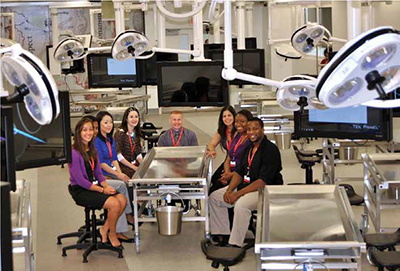- Located directly across from Philadelphia on the New Jersey side of the Delaware River, the city of Camden has a troubled history of urban dysfunction. In a step to help revitalize the city, Rowan University and the Cooper Health System have collaborated on a new teaching facility that integrates the latest AV technologies throughout the new six-story building.
The $139 million, 200,000-square-foot Cooper Medical School of Rowan University (CMSRU), the first new medical school in the state in more than 35 years, officially opened in late July 2012. The partners expect the facility to help address the unfortunate facts that New Jersey ranks 33rd in medical school graduates per capita, and that over 30,000 South Jersey residents annually cross the river to Pennsylvania for specialty care.
The 50 students of the incoming class of 2016 were selected from a total of almost 2900 applicants. In order to demonstrate a commitment to urban medicine in general and to Camden in particular, CMSRU requires its students to contribute 40 hours of community service around the city during their time at the school. The school’s plans allow for expansion of the class size to 100 students, and eventually 400 at full capacity. The faculty includes 450 clinicians from Cooper in addition to the school’s own team.
Gearing Up
From the main auditorium and multipurpose room on the first floor to the 25 active learning group rooms, gross anatomy room, clinical simulation center, and other learning spaces on the upper floors, the entire facility is wired and outfitted with AV technologies throughout to enable the recording and review of its classes by students, alumni, and faculty. “We record all of our lectures using a cloud-based software called Tegrity,” explains Joe Ferrarie, manager of information technology, CMSRU.
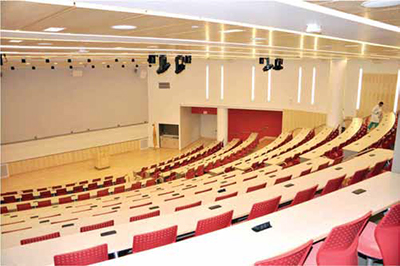
“We have a bunch of iMacs in the control room and everything is recorded and dumped digitally onto those. From there we can do our editing and push it out in any way that we need it. The software records all the video and audio to the local computer, and as soon as it’s done, it uploads it. The students have access to the lectures 15 minutes after the class is out.”
Students can watch the lecture immediately or review past classes prior to tests. “They can speed up the video up to four-times speed,” adds Ferrarie.
“We’ve had a couple of instructors already who didn’t have enough time within a class, so they’ve done recordings at home and posted them online for the students. It’s a nice feature that the faculty members are definitely utilizing.”
The main auditorium, which seats 250, is located on the first floor. “We have four cameras that can record the entire room, and four projectors that allow us to project two separate images or overlap each other and project one extremely bright image,” he says.
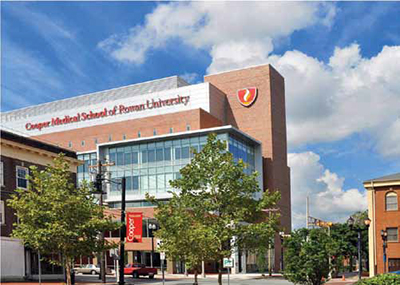
The main control room behind the auditorium acts as a central hub for the distribution of AV signals throughout the fiber-networked facility. “Crestron was the main provider for most of the tools,” reports Ferrarie. “We can pump any kind of video feed into that room, and we can also take the video feed from the cameras in that room and put it into any of the other rooms within the building.”
According to Ferrarie, the initial architect for the AV system was Jonathan Kendall of Kendall Design Group in Annapolis, MD. AVISPL integrated the AV equipment. “Howard Hindsmann [AV installation project manager] was the main person on campus. He did most of the wiring and got everything set up. Tod Andrews came in once the building was completed and did most of the programming, especially for the Crestron units.”
Also on the first floor, a 125-seat space referred to as the multipurpose room can be divided into three smaller rooms. “We have three projectors in there as well, and we have speakers throughout the room. We can do pretty much anything there, as well.”
Study Halls
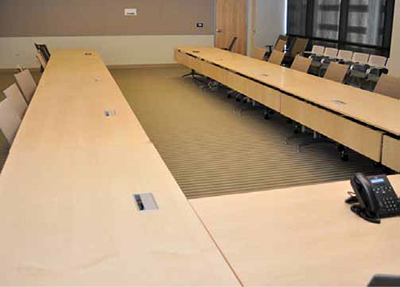
The 25 active learning group (ALG) rooms are where students break off into their smaller learning groups, Ferrarie continues. “Inside each of those rooms we have a 50-inch television that we have computers hooked up to, or we have a wall box where the students can attach anything they need into the television. We have a camera and microphone, also, in every single ALG, so they can record their interactions. Everything is being controlled by an iPad using Crestron Control. The students seem to love that.”
The gross anatomy room, which is not yet completed, houses 19 stations: one for the instructor plus 18 students. “Each station has its own 40-inch touchscreen computer at every gurney. At the instructor’s station, the lighting mechanism above the gurney has a camera built into so that the faculty member can use that camera and project it onto any of the other 18 student screens. We also have the ability to record that, and we can actually project what’s going on in that room into the auditorium. That’s a really nice feature,” he comments.
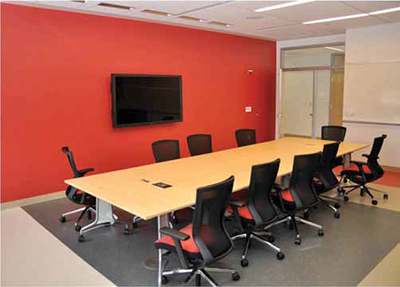
“We have a simulation lab that is really state of the art,” he continued. “It has 12 OSCE (Objectively Structured Clinical Examination) rooms and four simulation labs. The OSCE rooms all have two cameras and four microphones to record anything that’s going on within those. In the sim lab, where we will have the mannequins — which we’re in the process of getting — they have four cameras and four microphones.” A proctor can sit in the control rooms located between each of the simulation rooms and control the simulator and communicate with each room’s occupants.
CMSRU also houses three Polycom videoconferencing units. “One is in a dedicated conference room that can seat 50 people. The auditorium has a Polycom unit built into it, and we also have a mobile Polycom unit that we can bring into any of the other conference rooms if necessary,” says Ferrarie.
“We’ve got a lot of bells and whistles in here,” he concludes, “and they’re working out really well. It was really well thought out.”
Steve Harvey (psnpost@nbmedia.com) has been west coast editor for Pro Sound News since 2000 and also contributes to SystemsContractor News, TV Technology, and Pro Audio Review.
